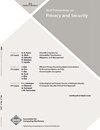Eyes See Hazy while Algorithms Recognize Who You Are
IF 3
4区 计算机科学
Q2 COMPUTER SCIENCE, INFORMATION SYSTEMS
引用次数: 0
Abstract
Facial recognition technology has been developed and widely used for decades. However, it has also made privacy concerns and researchers’ expectations for facial recognition privacy-preserving technologies. To provide privacy, detailed or semantic contents in face images should be obfuscated. However, face recognition algorithms have to be tailor-designed according to current obfuscation methods, as a result the face recognition service provider has to update its commercial off-the-shelf(COTS) products for each obfuscation method. Meanwhile, current obfuscation methods have no clearly quantified explanation. This paper presents a universal face obfuscation method for a family of face recognition algorithms using global or local structure of eigenvector space. By specific mathematical explanations, we show that the upper bound of the distance between the original and obfuscated face images is smaller than the given recognition threshold. Experiments show that the recognition degradation is 0% for global structure based and 0.3%-5.3% for local structure based, respectively. Meanwhile, we show that even if an attacker knows the whole obfuscation method, he/she has to enumerate all the possible roots of a polynomial with an obfuscation coefficient, which is computationally infeasible to reconstruct original faces. So our method shows a good performance in both privacy and recognition accuracy without modifying recognition algorithms.眼睛看到模糊,而算法识别你是谁
人脸识别技术已经发展和广泛应用了几十年。然而,这也引起了人们对隐私的担忧和研究人员对面部识别隐私保护技术的期望。为了保护隐私,人脸图像中的细节或语义内容应该进行模糊处理。然而,人脸识别算法必须根据现有的混淆方法进行定制设计,因此人脸识别服务提供商必须针对每种混淆方法更新其商用现货(COTS)产品。同时,目前的混淆方法没有明确的量化解释。本文提出了一种基于特征向量空间的全局或局部结构的通用人脸混淆方法。通过具体的数学解释,我们证明了原始和模糊人脸图像之间距离的上界小于给定的识别阈值。实验结果表明,基于全局结构的识别退化率为0%,基于局部结构的识别退化率为0.3% ~ 5.3%。同时,我们证明了即使攻击者知道整个混淆方法,他/她也必须枚举具有混淆系数的多项式的所有可能根,这在计算上是不可实现的,无法重建原始人脸。该方法在不修改识别算法的情况下,在隐私性和识别精度方面都有较好的表现。
本文章由计算机程序翻译,如有差异,请以英文原文为准。
求助全文
约1分钟内获得全文
求助全文
来源期刊

ACM Transactions on Privacy and Security
Computer Science-General Computer Science
CiteScore
5.20
自引率
0.00%
发文量
52
期刊介绍:
ACM Transactions on Privacy and Security (TOPS) (formerly known as TISSEC) publishes high-quality research results in the fields of information and system security and privacy. Studies addressing all aspects of these fields are welcomed, ranging from technologies, to systems and applications, to the crafting of policies.
 求助内容:
求助内容: 应助结果提醒方式:
应助结果提醒方式:


